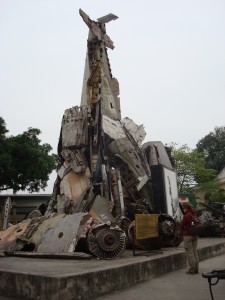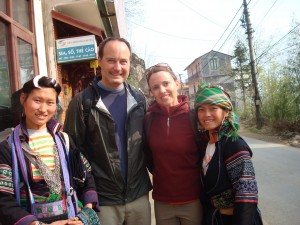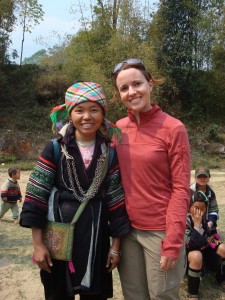Arriving in Hanoi is a reminder that everything is relative. The weather was colder and damper, and traffic moved a lot faster than in Cambodia. The temperature was in the 50’s and 60’s, but felt freezing after six weeks of weather that never dropped below 75 degrees. Crossing the streets was a risky venture for the first two days. I recalled my mom telling me what her father told her when he taught her to drive: “Head on springs!”, meaning look both ways at least twice before crossing the road. Sound advice. I kept repeating it to myself and we have managed to avoid getting run over to date (thanks, Grandpa!).
The weather in Hanoi was a big disappointment. As mentioned above: cold, damp, foggy and misty (smoggy?). We never saw the sun the entire time we were there. We kept hoping the hot tropical sun would burn through, but every day the sun lost the battle and the dingy gray layer prevailed. Our fleeces and socks were put to good use.
Our first day in Hanoi, we ticked off a lot of the tourist attractions: Ho Chi Minh’s Mausoleum, Ho Chi Minh’s residence, the Vietnam National Museum of Fine Arts, and the Army Museum.
We found the Army Museum the most interesting; it had lots of heavy military equipment captured from the Americans during “The American War”. It was fascinating to see the war from a Vietnamese perspective, including reading exhibit signs about the “American aggressors”. As we learn more from readings, museums and our guides, it is eye-opening to realize that the Vietnamese have a long history of fighting (and winning) wars – against the Chinese, the French, the Americans, the Chinese again…and the American war seems to have a much smaller hold on the collective consciousness here than it does at home. Perhaps because they won?

Army Museum sculpture of destroyed American and French planes, tanks, etc.
We also visited Sapa, a town in northwest Vietnam near the Chinese border. Sapa is known for its beautiful mountains and ethnic hill tribes. To get there, we took a night train to Lao Cai. The train left Hanoi at 9:00 pm and arrived at 5:00 am, traveling at an average speed of 20 MPH (a fast biker could have done better). We shared a 4-person soft sleeper car with two Chinese businessmen. Since our Mandarin is non-existent and their English extended as far as “hello”, we had a relatively quiet evening.
The town of Sapa is nestled in the hills and surrounded by terraces of rice paddies. Several hill tribes live in villages around Sapa, including the Black H’mong and Red Dao tribes. It was very easy to meet the tribeswomen, as there were several of them waiting for us as we walked out of our hotel. Two pretty young women laden with handicrafts attached themselves to us as we walked through town searching for a trekking guide office.
Their names are Bai and Moo, and both are 20 years old and from the Black H’mong tribe. Both are married; Bai has a two-year old son and Moo is hoping for a child soon. She has only been married eight months, so it is a little soon. They learned English from speaking with the tourists. We learned all this and more over the course of the 1 1/2 hours they followed us around town. They asked us several questions too, “where you from?”, “do you have any children?”, “how long you in Sapa?”, “how old are you?” etc.
Normally I would find being followed around by anyone very annoying. But somehow, it wasn’t – they were just so sweet. And sincerely sweet, we just couldn’t tell them to bugger off. Sure, they wanted to sell us their wares, but they were so absolutely charming about it. And so now we have two hand-embroidered pillowcases: one each from Moo and Bai.

Moo & Bai - incredible Black H'mong saleswomen
We spent the next two days in Sapa trekking through fields amongst villagers, water buffalo, pigs, puppies and chickens. Most dogs were not friendly in Sapa; even the puppies would run from a friendly foreigner.
We hired a guide from Topas Travel, Cuong, for an all-day trek. Cuong also brought along a guide-in-training, Tang, who is the little brother of a good friend (friendships and family ties are very strong in Vietnam, and strongly influence how/if things get done). We started in Sapa, and descended through fields of sorrel and watercress to the Muong Hoa river. We were glad to have a guide, because it felt like we were walking through people’s yards. It turns out the definition of public path or road is loose in Sapa.
We met several other tribeswomen along the way, but very few men. While the women dress in colorful and identifiable clothing, the men’s dress is non-descript. While many women sold handicrafts, men worked in the fields.
All the women we met spoke quite a bit of English, and many spoke French, Japanese and Korean too. All learned these languages from interacting with tourists, as they only learn Vietnamese in school.
I met one Black H’mong woman who is the same age as I am. It was a glimpse of a path not taken: she has three children, the oldest of which just got married. It definitely made us realize we’re a little behind the ball on the procreation front, at least by Black H’mong standards!

Same age, and she's a mother of three
Upon return to Hanoi we were joined by Mark’s parents, Donald and Ann. We spent a couple days in Hanoi, then traveled to Ha Long Bay and spent a night on a junk. Ha Long Bay is a UNESCO Heritage site, and is comprised of about 1,600 limestone islands and islets.
Unfortunately, the tour was very tightly controlled and our junk followed 20-30 other junks around to the mandatory sights…while just in the distance we could see huge swaths of water and islands where there were no people or boats! Mark and I took a kayak out and decided that if we ever come back to Ha Long Bay, we will do a kayaking tour during a warmer season to get the best experience of the islands.
We flew to Hue two days ago, and have been enjoying sunny, warm weather and lots of tropical fruit. Hue is the ancient capitol of Vietnam, and is the religious and intellectual capitol of the country today. It is a beautiful city moving at a slower pace, and we’ve enjoyed it. Tomorrow we fly to Nha Trang for three days with no official plans. Mark and I hope to dive the local islands and perhaps visit a mud bath and hot springs resort.
{ 4 comments… read them below or add one }
Hi Mark and Allie,
Stu and I just received your pictures from the similan. They are really cool. It was a real pleasure to look at them and remembering everything, specially because our pictures from this trip are unfortunatly very very limited. So thank you very much for that. I miss thailand so much.
After the trip we realised we were really short on money, so we decided to go back a bit earlier to new zealand and get a job.
stu got a job straight away, when I am still struggling. But we found a really good flat, and I hopefully will get a job soon.
I have been reading your advendtures from vietnam. so much memories. Shame you didn’t get the sun in hanoi !
If I understood well, you are not going to hoi an ? If you ever go back to vietnam, go to this city. It is the most lovely one of vietnam.
New zealand winter will be here soon. We can already feel that the wind is really getting cold and the rain show up now and on, so we enjoy the last days of sun going to the beach or visiting island close to auckland.
I really hope you will enjoy the rest of you trip.
we wish you the best
amelie and stu xxx
We received a postcard today & had fun passing it around in class. We also have a few more questions. 🙂 What is a “junk”? Obviously you are not speaking about garbage. How many languages have you learned during your travels? Can you take a picture of your next meal & share it online? Did the woman that is your age show you around her home? If so, what was it like? Are their homes similar to ours?
Thank you for sharing your adventures with our class.
Sincerely,
Ms. Jamison’s 4th grade class
PS – Natalie’s father is from Battambong, Cambodia.
Hi Ms. Jamison & Class,
Thanks for joining us on our adventures! I’ll try to answer your questions as best I can…
1. A junk is a type of boat – usually a traditional wooden boat. This is a picture of our junk.
2. Languages…most of the locals we interact with know a lot of English, so we haven’t had to learn another language. We do learn a few important phrases in each language, like “Hello”, “Thank you”, and “Too expensive!” – the last one comes in handy when we’re bargaining for taxi rides.
3. Pictures of a meal – yes, will do. It takes us (well, mostly Mark) awhile to edit and organize our photos before we upload them. For every picture we upload, there are probably three or four we leave out. We’re still catching up on our Vietnam photos, and hope to have more uploaded tonight/tomorrow.
4. The woman in Sapa – we did not get to see her home, because we met her out on the trails and she was walking with another group. We saw a lot of homes from the outside, and we’ll have some photos uploaded tonight/tomorrow. We went inside one home for lunch, and it had a dirt floor and a small kitchen with an open charcoal grill in the corner. Most of the homes were small and made of wood.
We didn’t get a chance to go to Battambong while in Cambodia, but we heard it was a beautiful city with lots of gorgeous French colonial buildings.
Thanks for writing, and feel free to send us more questions! We’re in Laos now, and head to Japan in about three weeks.
~Allie
Hi Amelie,
Good to hear from you, and glad you got the photos. We haven’t been near a beach or ocean water since the Andaman, and we’re missing it! What a fantastic trip. We really enjoyed meeting you and Stu.
We didn’t make it to Hoi An, and we met a lot of other people who shared your thoughts on it – we will go next time! We spent a few days in Nha Trang and did two dives there. Very different conditions from the Andaman, and the water was only 26 degrees! We wore full-body wetsuits. We got lucky with a really good divemaster and he showed us jellyfish, an octopus, and even two turtles. We also swam through some small caves, which was a little nerve-wracking when my tank hit the top of the cave. Luckily, those tanks are tough :^)
Enjoy the last few warm days in New Zealand and good luck on landing your next job!
Allie & Mark
{ 1 trackback }